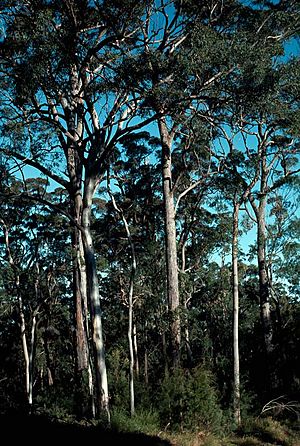Eucalyptus longirostrata facts for kids
Quick facts for kids Grey gum |
|
|---|---|
 |
|
| Eucalyptus longirostrata on the Blackdown Tableland | |
| Scientific classification | |
| Genus: |
Eucalyptus
|
| Species: |
longirostrata
|
| Synonyms | |
|
Eucalyptus punctata var. longirostrata Blakely |
|
Eucalyptus longirostrata, commonly known as the grey gum, is a type of tree. It is found only in south-east Queensland, Australia. This tree has smooth, grey bark and shiny green adult leaves. Its flowers are white and grow in groups of seven. The fruit of the grey gum looks like a small cup.
Contents
What the Grey Gum Looks Like
The grey gum is a tall tree that can grow up to 30 m (98 ft) high. It has smooth, grey bark that peels off in strips. Unlike some other trees, it does not form a special woody lump at its base called a lignotuber.
Leaves
When the tree is young, its leaves are shaped like a wide spear. They are 40–100 mm (1.6–3.9 in) long and 12–27 mm (0.47–1.06 in) wide, and they are lighter in color on the underside.
As the tree gets older, its leaves become shiny green on top and paler underneath. These adult leaves are also spear-shaped, measuring 80–180 mm (3.1–7.1 in) long and 13–35 mm (0.51–1.38 in) wide. They narrow down to a stalk called a petiole, which is 10–25 mm (0.39–0.98 in) long.
Flowers and Fruit
The grey gum's flower buds grow in groups of seven. They are found where the leaves meet the stem. Each group of buds sits on a flat, unbranched stalk called a peduncle, which is 8–18 mm (0.31–0.71 in) long. Each individual flower bud has its own small stem, called a pedicel, about 2–7 mm (0.079–0.276 in) long.
Mature buds are oval-shaped, 7–15 mm (0.28–0.59 in) long and 4–8 mm (0.16–0.31 in) wide. They have a long, beak-like cap called an operculum. The grey gum usually flowers in February and March, and its flowers are white.
After flowering, the tree produces woody fruit. These fruits are shaped like a half-sphere or a cup. They are 3–8 mm (0.12–0.31 in) long and 6–10 mm (0.24–0.39 in) wide. The parts that release the seeds stick out above the rim of the fruit.
How the Grey Gum Got Its Name
This grey gum was first officially described in 1934 by a person named William Blakely. He gave it the name Eucalyptus punctata var. longirostrata. This description was published in his book, A Key to the Eucalypts.
Later, in 1988, two botanists, Lawrie Johnson and Ken Hill, decided that this variety was unique enough to be its own species. They changed its name to E. longirostrata in a publication called Flora of Australia.
The second part of the tree's scientific name, longirostrata, comes from two Latin words. Longus means "long," and rostratus means "beaked." This name refers to the long, beak-like cap (operculum) on its flower buds.
Where the Grey Gum Lives
The Eucalyptus longirostrata tree grows in open forests. You can find it on hills and ridges in Queensland, Australia. Its range stretches from the Blackdown Tableland all the way to the Toowoomba area.
Conservation Status
The Queensland Government has classified this eucalypt as "least concern" under its Nature Conservation Act 1992. This means that the tree is not currently considered to be at risk of disappearing.

